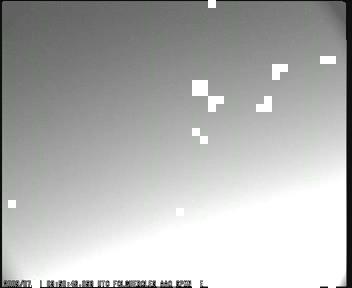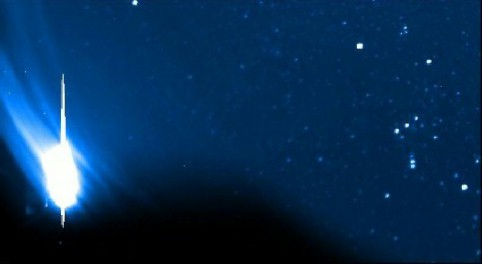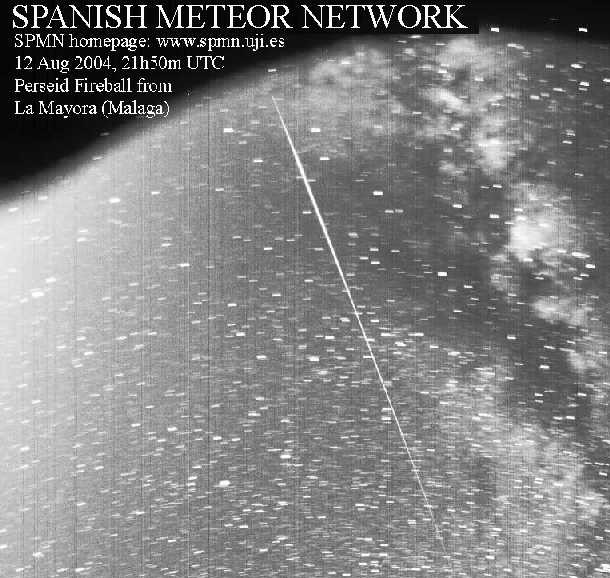The SPanish Meteor Network (SPMN) also known as Spanish Fireball Network was born in 1997 in order to study interplanetary matter, and
recover fresh meteorites for direct study in our laboratories. Up to now, the SPMN has promoted the recovery of two meteorites: the L6 ordinary
chondrite Villalbeto de la Peña (2004) and the eucrite Puerto Lapice (2007). Here is an
update of 2009 achievements
presented at the IAA planetary Defense Conference of Granada 2009. The network is still growing at a good rate with fundings received
from our different research projects, and public funds. In 2010 the network has about 25 video and CCD stations monitoring
the atmosphere for bright fireballs occurred over Portugal, Spain, north of Morocco and south of France. This research project is integrated by
researchers of several universities and research centers (Consejo Superior de Investigaciones Científicas, Institut d'Estudis Espacials de
Catalunya, Universidad de Castilla-La Mancha, Universidad Complutense de Madrid, Universidad de La Rioja, Universitat Politècnica de Catalunya,
Universitat de Valencia, and Universidad de Huelva). Since 1999 SPMN our activities increased with the idea to develop an automatized
Fireball Network in a short term in our country. We have developed the first high-resolution CCD all-sky cameras applied to fireball monitoring
in the world. Additionally, by studying casual records of the Jan. 4, 2004 superbolide we reconstructed the atmospheric trajectory and we got
the first meteorite recovery in Spain since 1947. In such event we got the heliocentric orbit of a meteorite in the solar system for the
first time in our country and ninth time in the world. From multiple-station meteor and fireball observations we are currently obtaining detailed
information on meteor showers and fireball events over Spain and bordering countries. Amateur astronomers are also participating in the SPMN network
coverage with specific observing programs. Our main aim is to increase the knowledge on meteoroid interaction with the atmosphere,
learn more about the dynamical mechanisms of meteoroid delivery to the Earth, and about the role that primitive bodies had on the
origin of life in the Earth. Our interdisciplinary team is studying these problems from all possible approaches, including
the mineralogical and chemical study of primitive chondrites. We are looking for young researchers with interest
to continue studies on meteorites and related fields in Spain.

Low-res video of magnificent bolide SPMN300509 recorded from several stations in Barcelona province on May 30, 2009. Pep Pujols (AAO) and J.M. Trigo-Rodriguez (CSIC-IEEC).
ALL-SKY HIGH-RES CAMERA DEVELOPMENT
SPMN researchers have developed an all-sky CCD automatic system for detecting meteors and fireballs
that is currently operative in two stations in Andalusia and will be operative in four stations in Spain by the summer of 2005.
The capabilities of this all-sky system were demonstrated with the detection of the Jan 27, 2003 Nador superbolide of -17±1 absolute
magnitude and was registered by our prototype located more than 500 km away that the ending point of the fireball.
The cameras were developed following the BOOTES-1 prototype installed at the El Arenosillo Observatory in 2002 that provides an all-sky
image with enough resolution to make accurate astrometric measurements. Nowadays, several all-sky CCD cameras from the operative
stations are continuously taking images of the night sky, recording meteors and fireballs. The stellar limiting magnitude of the images
is +10 in the zenith, and +7.5 below ~75º of zenithal angle.

The 27th January 2003 superbolide of magnitude -17 detected at the BOOTES-1 station located at El Arenosillo (Mazagón, Huelva)
after first light in Dec 2002, by the newly developed CCD all-sky camera. This impressive fireball overflew Algeria and Morocco, being
recorded from El Arenosillo that was more than five hundred kilometers away. The true trajectory of the fireball is inclined 30º
clockwise, and it was also registered with the medium-field CCD cameras. This image is a good example of the capability of this all-sky CCD
system. More details on this superbolide (in Spanish)
For the first time, all-sky systems are able to record meteors from
magnitude +1/+2. The excellent limiting stellar magnitude of our cameras provide enough comparison stars to make astrometric and
photometric measurements of faint meteors and fireballs with an accuracy of 1.5 arcminutes. The high efficiency of the system also makes
it applicable for detecting optical counterparts of Gamma Ray Bursts (GRBs), following of variable stars or even for the coverage and
discovery of unexpected bright Near Earth Objects (NEOs). Using this prototype we are currently monitoring the sky from four automatic all-sky CCD stations, two in Andalusia and two in
the Valencian Community, and Catalonia. In addition to the all-sky CCD coverage, we use high-resolution video cameras.

Low-resolution image of an impressive -6 Perseid fireball detected from La Mayora station of the SPMN on August 12, 2004.
(Instituto de Astrofisica de Andalucia and University of Valencia)
STUDY OF SUPERBOLIDES
Some fireballs called superbolides can be detected in broad daylight, and even from the space, from monitoring
satellites. We are also studying an impressive daylight fireball observed from Spain, Portugal and South of France at 16h46m45s (±2s)
UTC on January 4, 2004. Such superbolide produced audible booms, and the associated airwave was also detected seismically. Our team
recovered several meteorites of the nearly 5 kg recovered until date. The fall has been called Villalbeto de la Peña, from the village of
the same name located in northern Palencia (Spain) where the first meteorites were recovered. This daylight fireball was recorded by several casual eyewitnesses using video and
photographic cameras from where the atmospheric trajectory and heliocentric orbit of the progenitor meteoroid has been
obtained. More information on the January 4, 2004
superbolide

The impressive fireball “Vall d’Alba” (SPMN930801) was recorded from two stations of the Spanish Photographic
Meteor Network in August 1993. It was produced by a ca. 300 g fragment of comet P/Swift-Tuttle, entered the atmosphere at
about 60 km/s, being completely ablated at a height of 70 km. Picture of Ph.D. Josep M. Trigo (SPMN) from Valdelinares
Peak (Teruel)
CURRENT STATUS OF THE NETWORK
The activities carried out by the SPMN are mainly based on the study of meteors, fireballs and
meteorites. Different types of studies are being performed, such as the calculation of meteoroid orbits from conventional
photography, video and CCD techniques, stream's spatial densities, elucidation of meteor parent bodies, meteor spectroscopy,
meteor atmospheric modelling, identification of meteorites and meteorite recovery, and development of meteor software.
The Spanish Photographic Meteor Network is particularly aware of the importance of popularizing all these aspects to the
people, and different types of efforts are conducted. Several amateur astronomers collaborate with the SPMN, allowing a continuous scan of meteor events from several stations. The first four station all-sky
CCD cameras with rotating shutters, and allowing a full coverage of meteoric activity will start operation during 2005.
Our all-sky CCD cameras not only detect fireballs if not also meteors brighter than magnitude +3, and will bring interesting
estimations of the flux density of annual streams and elusive minor showers. For an updated
list of our publications see:

Currently operative and future SPMN stations.
This English version of our SPMN homepage is not updated periodically. Please
refer to the list of publications, many available for downloading,
or to the Spanish and Catalan versions of our homepage for additional information. You may also translate easily our pages using e.g. Babel Fish. More information can be requested to our
e-mail |




